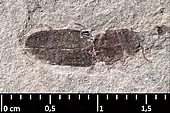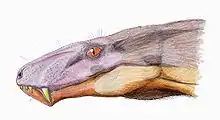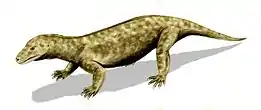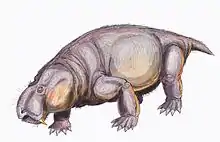1937 in paleontology
Paleontology or palaeontology is the study of prehistoric life forms on Earth through the examination of plant and animal fossils.[1] This includes the study of body fossils, tracks (ichnites), burrows, cast-off parts, fossilised feces (coprolites), palynomorphs and chemical residues. Because humans have encountered fossils for millennia, paleontology has a long history both before and after becoming formalized as a science. This article records significant discoveries and events related to paleontology that occurred or were published in the year 1937.
| |||
|---|---|---|---|
Arthropods
Insects
| Name | Novelty | Status | Authors | Age | Unit | Location | Notes | Images |
|---|---|---|---|---|---|---|---|---|
|
Protrogosita[2] |
Gen et sp nov |
valid |
Piton & Théobald |
A Trogossitid bark gnawing beetle |
 Protrogosita distincta | |||
Vertebrates
Data courtesy of George Olshevsky's dinosaur genera list.[3]
| Name | Novelty | Status | Authors | Age | Unit | Location | Notes | Images |
|---|---|---|---|---|---|---|---|---|
|
Gen et sp nov |
valid |
Riabinin |
||||||
|
Gen et comb nov |
Valid |
| ||||||
| Name | Status | Authors | Age | Location | Notes | Images |
|---|---|---|---|---|---|---|
|
Valid |
Olson | 255 Millions of years ago | A Gorgonopsian. | |||
|
Junior Synonim |
Junior Synonim of Thrinaxodon. | |||||
|
Valid |
||||||
|
Valid |
||||||
|
Valid |
||||||
|
Valid |
||||||
|
Valid |
Broom | 255 Millions of years ago | One of the Earliest-Known Cynodonts. | |||
|
Valid |
Young | 245 Millions of years ago | A Chinese Kannemeyerid Dicynodont. | |||
Popular culture
Amusement parks and attractions
- August 28th: The Calgary Zoo's Prehistoric Park opened. Paleontologist Darren Tanke has described Prehistoric Park as "an extensive treed park and pathways containing numerous life-sized concrete dinosaurs and other prehistoric life". It also had "two long, walkthrough display buildings containing a Corythosaurus skeleton and individual dinosaur bones", as well as exhibits of paleozoic invertebrates and prehistoric plants. It became a popular attraction among visitors to the zoo.[6]
Literature
- In 1937, Morant imagined a feathered dinosaur-like animal that lived during the Triassic and glided about on four wings. This portrayal reflected contemporary scientific speculations attempting to reconstruct the hypothetical ancestor of birds. Fossils from China later revealed the existence of just this sort of animal.[7]
References
- Gini-Newman, Garfield; Graham, Elizabeth (2001). Echoes from the past: world history to the 16th century. Toronto: McGraw-Hill Ryerson Ltd. ISBN 9780070887398. OCLC 46769716.
- Piton, L.; Théobald, N. (1937). "Les lignites et schistes bitumineux de Menat (Puy-de-Dôme). II: Les insectes fossiles de Menat". Revue des Sciences Naturelles d'Auvergne. 3 (2): 76–88.
- Olshevsky, George. "Dinogeorge's Dinosaur Genera List". Retrieved 2008-08-07.
- Riabinin, A.N. 1937. A new finding of dinosaurs in the Trans-Baikal region. Ezheg Vserossijskogo Pal. Obstcg. 11: pp. 142-144.
- Sternberg, C.H. 1937. Classification of Thescelosaurus: A description of a new species. Proc. Geol. Soc. Amer. 1936: p. 375.
- D. H. Tanke. 2010. Lost in plain sight: rediscovery of William E. Cutler's missing Eoceratops. In M. J. Ryan, B. J. Chinnery-Allgeier, D. A. Eberth (eds.), New Perspectives on Horned Dinosaurs: The Royal Tyrrell Museum Ceratopsian Symposium. Indiana University Press, Bloomington 541-550.
- Sarjeant, W. A. S., 2001, Dinosaurs in fiction: In: Mesozoic Vertebrate Life, edited by Tanke, D. H., and Carpenter, K., Indiana University Press, p. 504-529.




